Stocks & Equities
Then Joseph said to Pharaoh, “The seven good cows are seven years, and the seven good heads of grain are seven years; it is one and the same dream. The seven lean, ugly cows that came up afterward are seven years, and so are the seven worthless heads of grain scorched by the east wind: They are seven years of famine.”
 When a bunch of hoary old traders sat under the buttonwood tree in New York City in 1792, they knew the point of a market.
When a bunch of hoary old traders sat under the buttonwood tree in New York City in 1792, they knew the point of a market.
It was a place where buyers met sellers and they traded on a mutually agreed price.
A market was a place where people took risks, overpaid, got bargains, failed, gained, and in the end pooled money to build canals, manufacturing, and international trade.
Times Change
Yesterday, we’ve discovered yet again that the stock market is a casino where the house always wins. Janet Yellen, the chief of the Federal Reserve, has yet again shown us that “price discovery” is meaningless and the advantages are for the well connected.
Kissing the Dove of Spring
Let’s just go back down memory lane. Late last year, Yellen said she would hike rates if unemployment was below 5% (it is) and inflation was stable (it is).
She stated that stocks were expensive (P/E of 17) and the economy was going to overheat. But she was robust and had a backbone. There would be no bubbles on her watch, so she raised rates in December a quarter point to 0.50%.
The market rallied in a reverse “sell the news” scenario. She went on to say that she would raise four more times this year. The market kept going up. It was 1999 all over again!
Then in the gloom and cold of February, she shuffled the point of her duckboot in the gray slush of a New York sidewalk and mumbled under her breath. Perhaps she was imprudent.
And so, with the gusty winds of late March blowing down the canyons of New York, she spied a rock dove, an omen, and said she wouldn’t raise after all. At least not until that utopian day in the stock market where growth returns, otherwise known as the second half of the year. And there might even be a QE4 if things get tough.
No Privy Here
I’m not privy to what information Yellen has or pays attention to. In her speech she talked a lot about a slowdown in China — so perhaps that’s the problem.
Or not. Who can tell? At least Greenspan carried an overstuffed briefcase on days he hiked rates, thus giving the speculators a fighting chance. This Fed gives the impression that it doesn’t know what is going on much less where it wants to go.
Your humble editor has spotted one pattern in the Fed going back to the 1990s. They talk up rate hikes, set up the shorts, and then blow them out. The market then notches higher and the whole game starts over.
Bubble and Bust
Over the long haul, every boom needs a bust to clear out the deadwood. Bailouts by definition lead to more bailouts. Failure, on the other hand, is self-correcting.
There is another dominant economy that never cleared out the deadwood and instead propped up the status quo with bailouts, low rates, and easing: Japan, the country that just announced industrial output dropped 6.2% in February.
This is what happens when you borrow and bail out repeatedly over the decades.
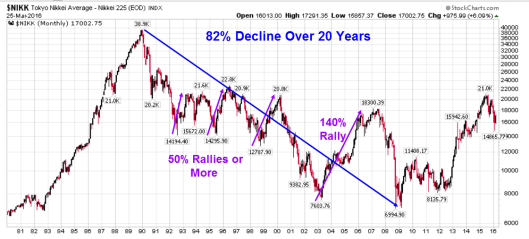
It’s worse than a market crash. It is a market crash followed by false hope after false hope. It’s 25 years of taking your money.
Buy, Hold, and Go Broke
Last week I told you the market looked like it was topping out. Forward earnings were abysmal and would have to be downgraded. You can read that here.
This week I’ll tell you the fundamentals are even worse. One of the pillars holding up this sham of a market has been stock buybacks. As you can see by this chart, that trend is also starting to reverse.
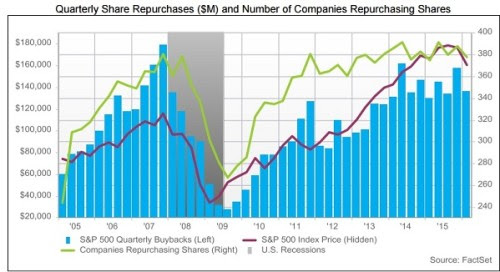
Note that the last time buybacks hit a zenith (in 2008), similar to the present,
it was right before the crash. As soon as stock buybacks ended, the stock market fell 50%.
If loans get hard to come by, buybacks are less of an option. Perhaps this is what the Fed is worried about.
Or maybe it’s the inventory-to-sales ratio:
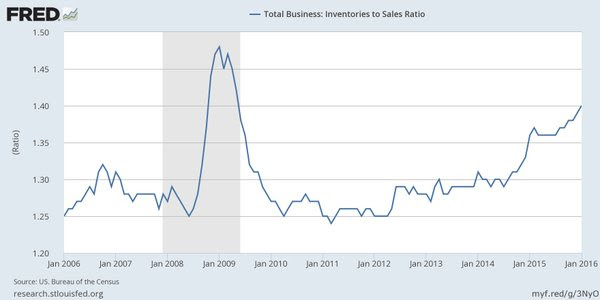
That’s a lot of product to have on the shelves. It must be worked off in one of three ways: writing it off, slashing prices, or cutting production and waiting.
And it’s not priced in. Here is the S&P 500 price-to-sales ratio.

History tells us that when the S&P 500 has a P/S ratio below 0.9, it will be up an average of 81% in five years. If the P/S is above 0.9, in five years, the market will be up only 4.7%.
As you can tell by the chart, we are now sitting at a 10-year high of 1.81 — twice the “buy” price.
That said, you can’t fight the Fed. Fundamentals no longer matter… until they do. Buy silver.
All the best,

Christian DeHaemer
Since 1995, Christian DeHaemer has specialized in frontier market opportunities. He has traveled extensively and invested in places as varied as Cuba, Mongolia, and Kenya. Chris believes the best way to make money is to get there first with the most. Christian is the founder of Crisis & Opportunity and Managing Director of Wealth Daily. He is also a contributor for Energy & Capital. For more on Christian, see his editor’s page.

Legendary investor Peter Lynch was fond of saying that corporate insiders may sell their company’s shares for a variety of reasons. But there’s only one reason they buy – and that’s because they think the price is going up.
Anyone at the director-level or above in Corporate America is considered an “insider” – and it’s perfectly legal for them to buy their own company’s stock. That’s a good sign in general, and especially for the stocks that we’re interested in. It means the executive buyer is bullish on dividend growth, and as we’ve discussed before, payout growth is what ultimately sends stock prices higher.
Executive teams from two of our Contrarian Income Report companies are, right now, using personal money to buy up their own cheap stocks and big dividends. That’s a big sign of confidence, and I’ll share the specifics in a minute. But first, let’s talk about a few more big payouts being bought by corporate insiders.
Seven 7% Dividends With Serious Insider Buying
Five insiders at Ares Capital (ARCC) have accumulated more than 150,000 shares for personal accounts over the last 3 months. These executives like their stock at 88 cents on the dollar. ARCC trades for just 88% of book value today, a bargain level it hasn’t yet seen this decade.


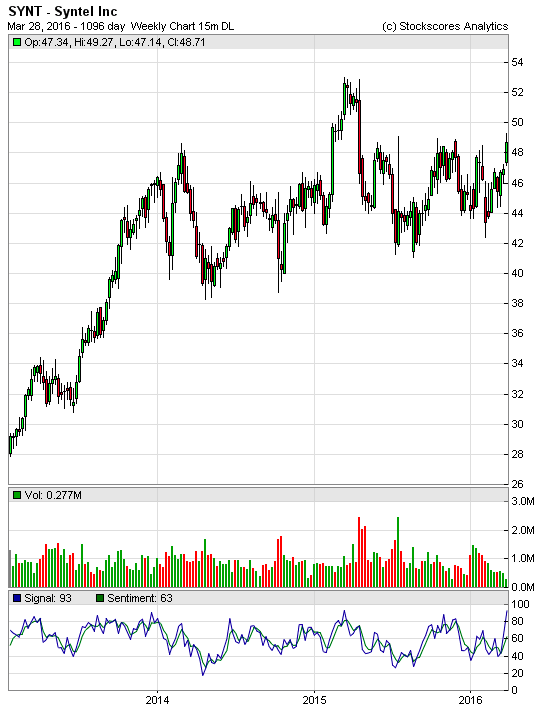 The ability to analyze a stock chart is essential to trading stocks whether you take a technical or fundamental approach. The chart shows us what all market participants know about a stock.
The ability to analyze a stock chart is essential to trading stocks whether you take a technical or fundamental approach. The chart shows us what all market participants know about a stock.
Most market beating stocks start their strong trends with abnormal price behavior. However, not all abnormal price behavior leads to a market beating trend. The key qualifier of abnormal price action is the stock chart. We can do well if we focus on the stocks trading abnormally out of predictive chart patterns.
That makes it important to understand the Stockscores Principles of Abnormal Chart Evaluation (SPACE) . To read any chart, you need to be able to see and understand the following:

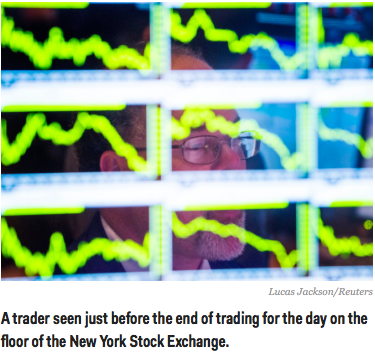 CREDIT SUISSE: Everyone else on Wall Street is dead wrong about these 23 stocks
CREDIT SUISSE: Everyone else on Wall Street is dead wrong about these 23 stocks
It’s usually easier to move with the crowd, even on Wall Street.
But counterintuitive behavior is often what rakes in the big returns.
The equity research team at Credit Suisse recently published its latest list of contrarian stocks, or companies it thinks Wall Street is reading wrong.

“A man sits as many risks as he runs.” ~ Henry David Thoreau
Robin Hood robbed the Rich to help the poor; in the modern day version the Rich rob both Robin Hood and the poor to become even richer. The rich in this case are the greedy corporations and the officers that run the show behind the scenes. In this lazy world, the only thing that matters is money and how to make as much of it as fast as possible. Hence, the best way to boost earnings without doing anything is to buy back boatloads of shares and in doing so artificially boost earnings. It is a perfect scam.
Companies in the S&P 500 Index are poised to purchase over $165 billion of stock this quarter, bringing us dangerously close to taking out the 2007 record. While Mutual funds and the masses are selling the corporate world is buying, proving that the dumb money is not in the know, even though their actions are based on valid data. Logic does not drive the markets; it’s emotions that are the main driving force behind the markets. $40 billion flowed out the markets via mutual fund sales or individual redemptions, but the corporate world more than covered that slack. One could call this is a positive divergence as the corporate world pumped this money into stocks when the markets were tanking, and the masses fled for the exits.
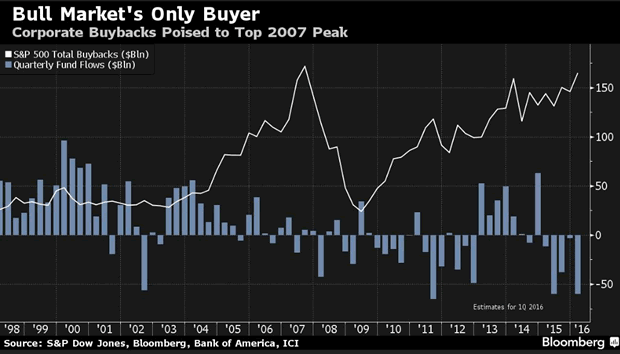
This record binge could continue and here’s why:
Central bankers worldwide are embracing negative interest rates and we all know that low rates favor speculation Look at what the current low rate environment has led to; imagine what will happen in the U.S if rates turn negative. We suspect an all out feeding frenzy will take place. The corporate world will rush in and borrow even more money; the masses will jump into stocks as it will look like earnings are rising, and everyone will have fun until the bottom drops out. The bottom always drops out, but it’s the average Joe that is left holding the can. Nothing has changed, and nothing will change going forward
“Anytime when you’re relying solely on one thing to happen to keep the market going is a dangerous situation,” said Andrew Hopkins, director of equity research at Wilmington Trust Co., which oversees about $70 billion. “Over time, you come to the realization, ‘Look, these companies can’t grow. Borrowing money to buy back stocks is going to come to an end.”‘
“Corporate buybacks are the sole demand for corporate equities in this market,” David Kostin, the chief U.S. equity strategist at Goldman Sachs Group Inc., said in Feb. 23 Bloomberg Television interview. “It’s been a very challenging market this year regarding some of the macro rotations, concerns about China and oil, which have encouraged fund managers to reduce their exposure.” ~ Full story
Companies in the S&P 500 are also flush with cash, so they can borrow the money in the open markets or use some of the cash they have been hoarding. According to Bloomberg, Non-Financial Companies in the SP500 had over $900 billion in cash at the end of 2015; the figure now is probably closer to $1 trillion.
Hedge funds and mutual funds have had a hard time making money over the past few years and have been net sellers as of late. Mass psychology states the masses that always get fried and compared to corporations that are buying back their shares, mutual funds and Hedge funds are sardines.
The Mass Psychology perspective
The trend is up regarding share buybacks, and as Central bankers worldwide are gravitating towards negative rates, it is fairly safe to assume that this trend will continue for quite some time. The masses are not revolting against this form of illicit behaviour and even though the dollar amount deployed to share buybacks continues to rise each year, we are not at the feeding frenzy stage. Hence, expect share buybacks to rise to insane levels.
Nothing short of rising rates could put a damper on share buybacks, and that is not something that will occur anytime soon. The second option is for Congress to pass new laws making restricting companies from blatantly repurchasing their shares with the sole intention of raising their earnings per share. As Congress shares the same bed with these corporate giants, don’t expect such a law to come into effect shortly.
Game Plan
The markets are being manipulated and will continue to be manipulated probably until the end of time, so until the trend changes or share buybacks grind to a halt, every strong pullback has to be viewed as buying opportunity.












